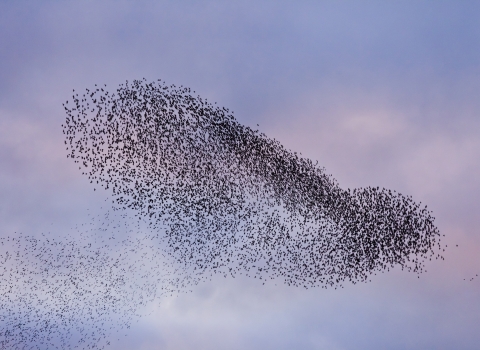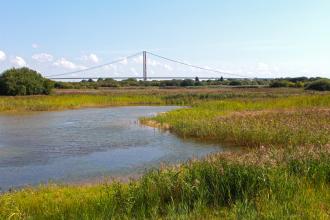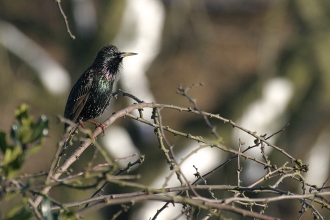Spectacular aerial displays
During the winter months, large numbers of starlings visit Britain from the continent, seeking out the relative warmth of our island climate. As dusk arrives, the starlings set off for their communal roost in one of the most staggering natural spectacles.
From November, starlings gather in their thousands and flock to form murmurations - performing incredible aerial displays, contracting and expanding and swirling back and forth in ever more complex and beautiful patterns.
When one bird changes direction, the seven closest birds also change direction. The whole flock keeps flying as one, like a giant three-dimensional Mexican wave.
Where to see them
For your best chance of seeing a starling murmuration, pick a clear, dry evening just as the sun is setting. Our Wardens and volunteers on site will let you know the best viewing spots on the reserves.
How to do it
Wrap up warm. Really warm. It can get surprisingly chilly standing waiting by a wintery reedbed, but it will be worth it, we promise. Arrive at least half an hour before the sun goes down, or even a bit earlier, and find a good vantage point where you can see both the roost site and the sky above. After you’ve had your fill and the last bird has dropped in to go to sleep, you can go back to that warm fire and cosy home. You may feel the cold, but we challenge you not to feel warm inside after a wondrous murmuration.
Starling factfile
What is a murmuration?
A murmuration is the name given to a flying flock of starlings. At dusk, the starlings arrive from all directions and, if the conditions are right, they begin gathering in the air in their thousands. They take on incredible shapes in the sky, contracting and expanding as one flock merges into another, and taking on a life of their own; swirling back and forth in ever more complex and beautiful patterns.
Enormous winter flocks of starlings can number more than a million birds!
Why do murmurations happen?
The synchronized movements may appear choreographed but there’s no grand plan. Biologists, physicists and mathematicians are working together to understand starling murmurations. From gathering for warmth to exchanging information, there are many theories about why starlings flock together in such large numbers. However it is widely believed that the main reason is safety in numbers.
If you are lucky enough to see a murmuration you may also notice sparrowhawks in the sky. These predators try catching the starlings, which causes the murmuration to condense and change shape incredibly fast. It is thought that each individual starling pays attention to and responds to their seven closest neighbours. When one bird changes direction, the seven closest birds also change direction. Sparrowhawks are rarely successful when the starlings are in such large numbers as it is difficult to choose one bird to target in the middle of a hypnotising flock.
When is the best time to see them?
The murmurations usually start in November, after the birds have all returned from their breeding sites and begun to gather as a flock again, but can sometimes be seen from as early as September. Numbers usually swell in December/January as migrant birds join our resident flocks for extra safety and warmth. If conditions are right, murmurations can still be seen up to February.
Pick a clear, crisp evening at dusk for your best chance of seeing them.
More about starlings
The starling is a familiar garden visitor that has a beautiful purple-and-green sheen to its black feathers. Sociable birds, starlings spend a lot of their time in large flocks, roosting and performing sweeping, aerial displays - they can often be seen moving fluidly through a wintry sky.
Starlings eat insects and fruit, and will visit birdtables and feeders. They make untidy nests in holes in trees or in buildings, in which the female lays five to seven eggs. Both parents raise the chicks.
















